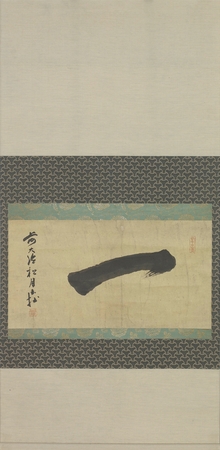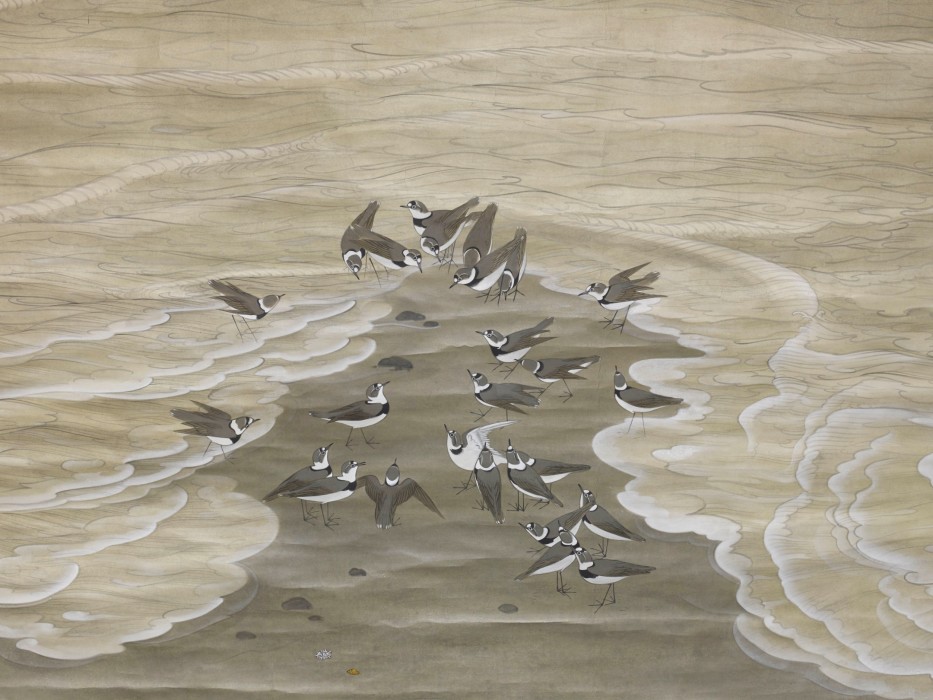Product Description
7368 Chūhō Sōu (1760-1838), the 418th Abbot of Daitokuji temple, Kyoto
A kakemono (hanging scroll) painted in ink on paper with the character ichi (one)
Signed: Zen Daitoku Shōgetsu rōsetsu (Former abbot of Daitoku-ji Shogetsu)
Seals:
Right: Kochū Jitsugetsu Nagashi* (lit. in the pot, sun and moon shine eternally)
Left: Chūhō
Japan 19th century Edo period
Dimensions:
Scroll: H. 118cm x W. 59cm (46½” x 23¼”)
Painting: H. 27cm x W. 50cm (10¾” x 19¾”)
Label on Awasebako (fitted wood box):
Zen Daikokuji Shōgetsu Sho Ichi (An Ichi painted by former abbot at Daitoku-ji Temple)
Chūhō Sōu (1760-1838). Gō (art names): Rakuyōjin, Hasui-kanjin, Shōgetsu, Shōgetsu-rōjin, Shōgetsu-sō. He was born in Kyoto and studied Zen Buddhism under Sokudō Sōki, the 406th Abbot of Daitoku-ji, the main temple of the Rinzai sect of Zen Buddhism in Kyoto. In 1807 Chūhō became the 418th Abbot of Daitoku-ji. After his abbotship he resided at Tokai-ji and then retired at the Shōgetsu-ken (The Studio of Pine and Moon) of the Hōshun-in, a sub-temple of Daitoku-ji. In 1936 he was granted the art name Daikō Shinjō Zenshi by Emperor Ninkō (1800-1846). Chūhō excelled in poetry, calligraphy, pottery and tea ceremony utensils. He died on the 8th of December, 1838, aged 79.
The character Ichi, a simple horizontal line which means “One”, is one of the most popular subjects of Japanese calligraphy. The expression “ichi-go ichi-e” (one time one chance) often associated with tea ceremony refers to the notion that every meeting with someone is unique and cannot happen again, it will never be the same twice. The idea being that life is transient, nothing is permanent, encourages us to be fully present in every moment. This is the essence of both the Way of Tea and Buddhism.
*The Kochū Jitsugetsu Nagashi (lit. in the pot, sun and moon shine eternally) is a Zen dictum referring to an episode in the biography of Fei Changfan as recorded in vol. 82 Biographies of Alchemists of the Chinese court document Hou Hanshu (History of the Later Han) which covers the history of the Han dynasty from 6 to 189 AD.
The Daoist immortal magician Hu Gong practiced medicine in a marketplace who hung a pot before his stand from which he produced cures for any malady. Fei Changfan, the market superintendent, noticed that Hu Gong would jump into the pot every night at the close of business. No one else had noticed this unusual behaviour and one day Fei Changfan decided to visit the old man’s stall, bowed to him and made an offering of food and drink. The old man saw that Changfan had realised his divine existence and invited him into the pot. Inside there were halls of jade filled with delicious liquors and meat delicacies. After spending an extraordinary few days in this parallel world, the old man swore Changfan to secrecy and they then returned to the market. However to Changfan’s surprise, not only a few days had passed but in fact nearly a decade. This is a clear symbolism of the relevance of time during meditation and how little significance time holds in the realm of enlightenment.
The world inside the pot was beyond time and space, representing an absolute world within our mind. The teaching is that the sun and moon shine within all of us, and by practicing zazen (seated meditation) we can realize the source of this true ‘Big Mind’ and our own absolute power.










